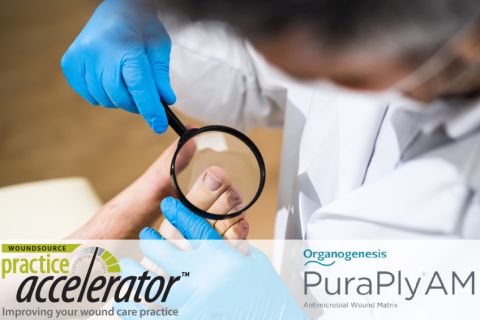What Is the Wound Telling You?
July 22, 2021
Wound healing can stall for a number of reasons. Wounds that have not healed or significantly reduced in size after four to six weeks are considered chronic. They are characterized by a multitude of impeding factors including biofilm, excess matrix metalloproteinases (MMPs) and extracellular matrix degradation, inflammation, fibrosis, unresponsive keratinocytes and fibroblasts, and atypical growth factor signaling. The vast majority of chronic wounds contain biofilm, which delays or stalls progression in the inflammatory phase of wound healing.1
Molecular and cellular abnormalities in chronic and hard-to-heal wounds lock in chronic inflammation, which plays a major role in suspending the normal healing process. The ultimate aim is to transform chronic wounds back into acute wounds to enable them to heal.2,3 Monitoring healing progress by checking wound status every two to four weeks can help determine what the stalling factors are, as can knowing what signs to look for within the wound — specifically, biofilm, granulation tissue and wound pain.
How much do you know about biofilm and inflammation? Take our 10-question quiz to find out! Click here.
Biofilm in Chronic Wounds
If the wound is not smaller after four to six weeks, biofilm may be present in the wound, signaling that the clinician should review the treatment plan. Identifying biofilms early on and adjusting the plan of care as necessary are both essential in optimizing wound healing outcomes.4 Clinicians should know how to effectively identify devitalized wound tissue types and the signs of bacterial imbalance.
Devitalized tissue (slough, eschar) impairs wound healing and should be removed as appropriate. Biofilm formation triggers a chronic inflammatory response in the wound that results in a high number of neutrophils and macrophages, which in turn leads to higher levels of reactive oxygen species and proteases ([MMPs] and elastase) that will then damage normal healing tissues, proteins and immune cells. Biofilm formation follows a common pattern of bacterial cell attachment, microcolony formation, maturation and dispersion. During the initial attachment, biofilm is reversible; if not reversed, the attachment becomes stronger, and cells begin to multiply rapidly.
They also begin to mutate so that they can compete in this now intensely crowded environment. At this point, the bacteria begin using quorum sensing, a communication process that enables the bacteria to regulate what genes they express as the cell population density increases.4-6 There is no fix-all solution or gold standard test for identifying or treating biofilm in a wound.5 Evidence suggests that physical removal (debridement) and continuous, vigorous cleansing are the best ways to reduce biofilm colonies.6 These strategies not only help prevent and manage biofilm, but also reduce antibiotic usage, thereby supporting antimicrobial stewardship. Using a combination of debridement methods is one way to battle biofilm in chronic wounds and accelerate healing.7 Sharp debridement is the most aggressive approach.
The clinician uses a scalpel, forceps, scissors and other surgical instruments to remove biofilm and devitalized tissue, stimulating platelets to release growth factors key to tissue repair and move chronic wounds into an acute state. Wound cleansers and solutions used in chronic wounds help decontaminate the wound, disrupt biofilm and promote healing. Cleansing the wound bed surface, periwound and surrounding skin with non-cytotoxic solutions is essential. Various delivery methods make them user-friendly for both the patient and clinician. Advanced wound care dressings can be used in chronic wounds to prevent and manage biofilm.
The wide array of impregnated dressing technologies includes antimicrobial formats in collagens, alginates, foams, hydrogels, gauzes and topical agents. Antimicrobial or bacteriostatic dressings may be impregnated with silver, cadexomer iodine, copper, methylene blue, gentian violet, polyhexamethylene biguanide (PHMB), etc. Used appropriately, these dressings and products have been found to be effective in chronic wound management. Once biofilm and infection have been resolved, clinicians should look for methods of encouraging wound closure.
Cellular and/or tissue-based products (CTP) can be one method of encouraging closure. CTPs come in a variety of formats, and may include collagens or antimicrobials such as silver or PHMB. They encourage wound closure by providing elements such as extracellular matrices, collagen, and other vital components that act as a scaffold for the healing wound. Encouraging rapid wound closure can ensure better outcomes for the patient, such as reduced costs, reduced pain, and better quality of life. CTPs that contain an antimicrobial component can provide a barrier against bioburden.
Granulation Tissue in Chronic Wounds
Irregular or unhealthy granulation tissue indicates poor healing and/or infection and requires a wound culture and appropriate treatment based on the culture results. Absent infection, chemical cauterization with silver nitrate or a topical steroid can be used to facilitate healing.8
Wound Pain
Numerous factors can cause wound pain, including underlying pathology/etiology, skin damage, nerve damage, blood vessel injury, infection and ischemia. Psychological and emotional factors can also trigger wound pain. Clinicians need to listen to their patients to help identify the type of pain, its cause(s) and the best treatment options. Because chronic pain impacts patients’ quality of life, appropriately managing the pain is paramount to achieving the best possible outcomes for patients.9 Practical knowledge of prognostic indicators and risk factors in chronic and hard-to-heal wounds — including biofilm, granulation tissue and wound pain — is essential to early identification, treatment and successful healing outcomes.

References
1. Murphy C, Atkin L, Swanson T, et al. International consensus document. Defying hard-to-heal wounds with an early antibiofilm intervention strategy: wound hygiene. J Wound Care. 2020;29(Suppl 3b):S1-S28.
2. Hayes, Skin Substitutes for Chronic Foot Ulcers in Adults with Diabetes Mellitus: A Review of Reviews, November 2018; Nicholas et al., 2016.
3. Liu Y, Panayi AC, Bayer LR, Orgill DP. Current Available Cellular and Tissue-Based Products for Treatment of Skin Defects. Adv Skin Wound Care. 2019 Jan;32(1):19-25.
4. Vowden P. Hard-to-Heal Wounds Made Easy. Wounds International. 2011;2(4):1-6. Available from: www.woundsinternational.com
5. Wolcott RD, Kennedy JP, Dowd SE. Regular debridement is the main tool for maintaining a healthy wound bed in most chronic wounds. J Wound Care. 2009;18(2):54-56.
6. World Union of Wound Healing Societies (WUWHS), Florence Congress, Position Document. Management of Biofilm. London: Wounds International 2016.
7. Ayello EA, Cuddigan JE. Debridement: controlling the necrotic/cellular burden. Adv Skin Wound Care. 2004;17(2):66-75.
8. Alhajj M, Bansal P, Goyal A. Physiology, Granulation Tissue. [Updated 2020 Nov 2]. In: StatPearls [Internet]. Treasure Island (FL): StatPearls Publishing; 2021 Jan. Available from: www.ncbi.nlm.nih.gov/books/NBK554402/
9. Frescos N. What causes wound pain?. J Foot Ankle Res. 2011;4(Suppl 1):22.
10. Wolcott RD, Kennedy JP, Dowd SE. Regular debridement is the main tool for maintaining a healthy wound bed in most chronic wounds. J Wound Care. 2009;18(2):54-56.
11. World Union of Wound Healing Societies (WUWHS), Florence Congress, Position Document. Management of Biofilm. London: Wounds International 2016.
The views and opinions expressed in this blog are solely those of the author, and do not represent the views of WoundSource, HMP Global, its affiliates, or subsidiary companies.












Follow WoundSource
Tweets by WoundSource